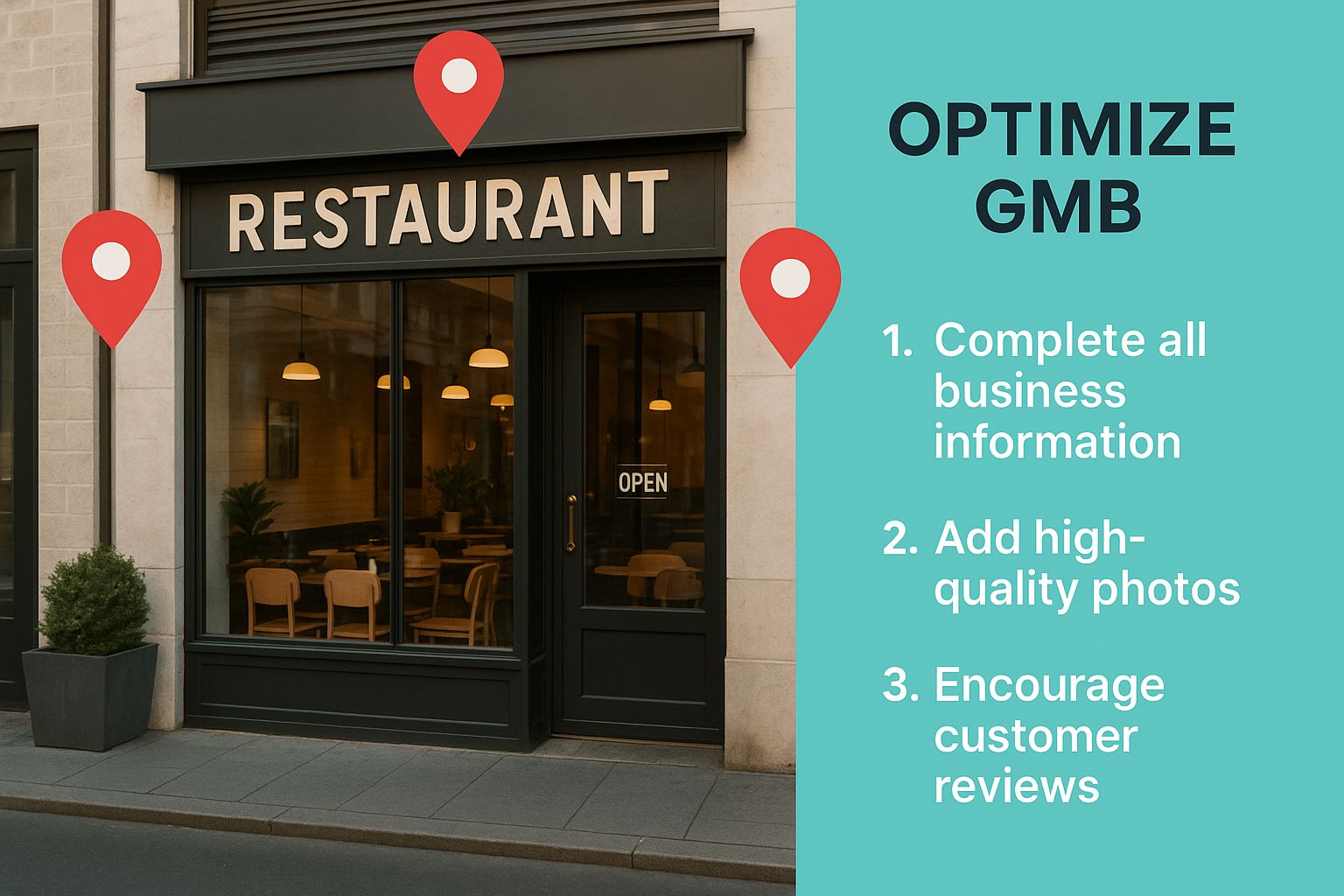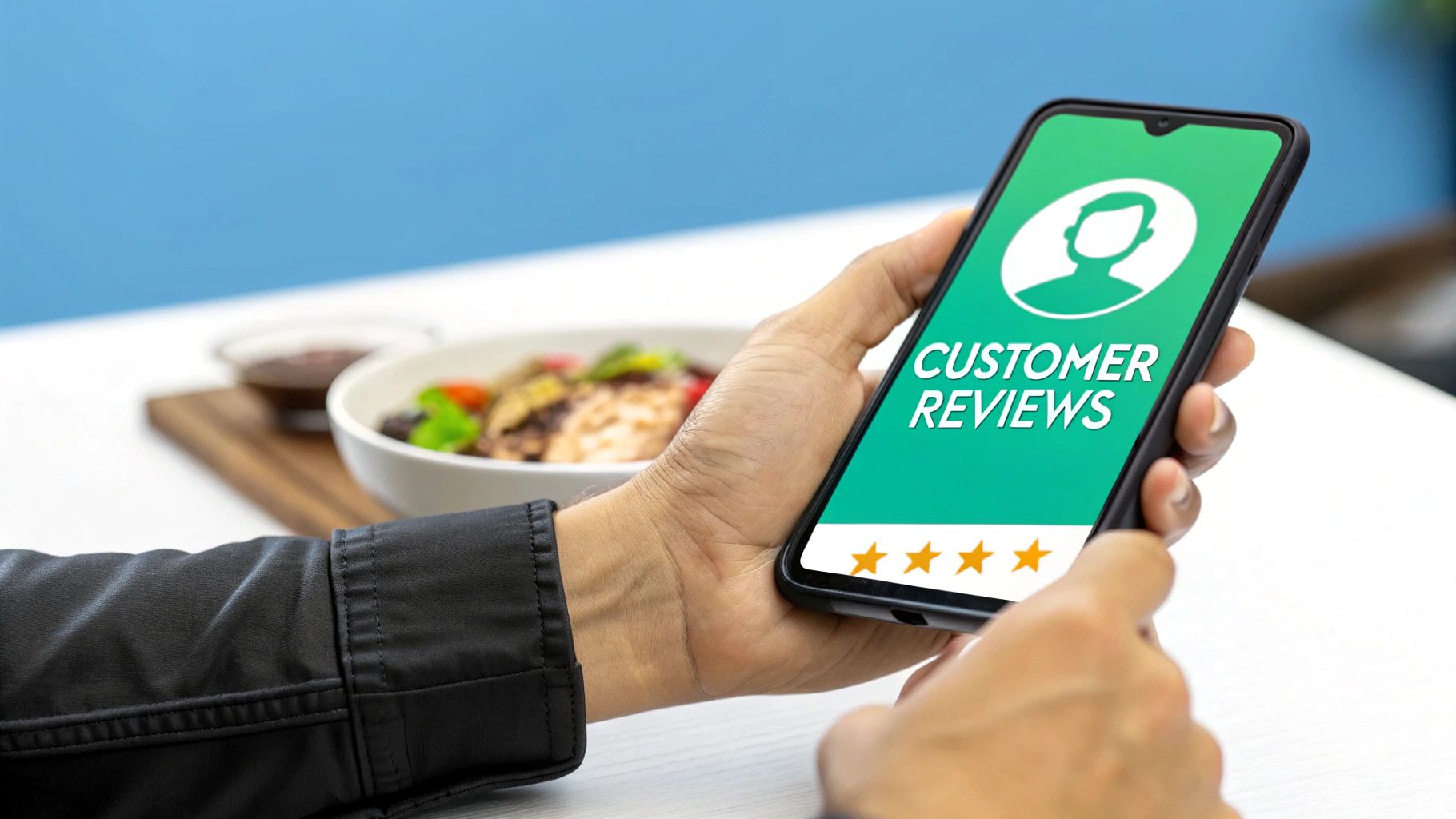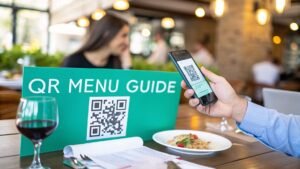Why Local SEO Is Make-Or-Break For Restaurant Success
The way people find restaurants has drastically changed. Instead of happy accidents or phone books, potential diners use their smartphones to search online. This means if your restaurant isn't in local search results, you're missing out on many customers. Restaurants that neglect local SEO are practically invisible.
Savvy restaurant owners know that local search engine optimization (SEO) is essential. They use it to compete effectively, even against large chains with bigger budgets. For example, a family-owned Italian restaurant can outrank a national pizza chain for searches like "best Italian food near me." Increased visibility means more customers and higher profits.
Understanding and implementing effective restaurant SEO strategies is crucial for maximizing online visibility. These strategies attract new customers and solidify your restaurant's standing in the community, encompassing everything from optimizing your online presence to managing your online reputation.
The Power of Online Visibility
Consumers regularly search for local businesses online. 8 in 10 US consumers conduct local searches at least weekly, including for dining options. Because 27.6% of users click on the first page of Google search results, appearing there can dramatically increase new customers. Find more detailed statistics here. This highlights the importance of a strong online presence, especially in competitive markets. Imagine your restaurant easily found when someone searches for "best sushi" in your city – that's the power of local SEO.
Local SEO: More Than Just a Listing
Successful local SEO for restaurants is a multifaceted approach. It's more than just a website; it's about creating a comprehensive online presence reflecting your restaurant's identity and offerings. This includes optimizing your Google Business Profile, managing online reviews, and building a strong local citation profile. You might be interested in: How to master local SEO. Mastering these core elements makes your restaurant visible and attractive to potential diners.
Mastering Your Google Business Profile Like A Pro
Your Google Business Profile (GBP) is your restaurant's online hub, often the first glimpse potential diners get. Optimizing it is key to attracting new customers. It's about more than just basic info; it's about showcasing your restaurant's personality.
Optimizing Your GBP: The Essentials
A complete and accurate GBP is the bedrock of local SEO for restaurants. Ensure your restaurant's name, address, and phone number (NAP) match across your website and online directories. This consistency builds trust with Google and customers. Keep your business hours current, especially for holidays and events, so customers know when you're open. High-quality photos of your food, ambiance, and staff are essential to attract diners.

This infographic illustrates the power of a well-optimized GBP, guiding customers to your physical location like a beacon. It's crucial for increasing online visibility and attracting local customers.
Leveraging Google Posts and Attributes
Google Posts let you share updates, specials, and events directly on your GBP. Use them to announce new menu items, promote offers, or highlight events. This keeps your profile fresh and engaging. They're like mini-advertisements within search results. Attributes highlight key features like "outdoor seating," "vegetarian options," or "live music," helping customers find what they need.
Keywords and Descriptions: Speaking Your Customer’s Language
The words you use on your GBP are as important as the visuals. Use relevant keywords naturally in your description. If you specialize in "vegan Thai cuisine," include those terms. Avoid keyword stuffing; focus on compelling descriptions that reflect your offerings. This helps Google connect you with the right diners.
To help you optimize your profile, we've created a handy checklist:
The following table outlines essential elements for optimizing your Google Business Profile and improving local search visibility.
Google Business Profile Optimization Checklist
Essential elements to optimize for better local search visibility
| Element | Optimization Strategy | Impact Level |
|---|---|---|
| Name, Address, Phone Number (NAP) | Ensure consistency across all online platforms | High |
| Business Hours | Keep updated, especially during holidays and special events | High |
| Photos | Include high-quality images of food, ambiance, and staff | High |
| Google Posts | Share regular updates, specials, and events | Medium |
| Attributes | Showcase specific restaurant features (e.g., outdoor seating, dietary options) | Medium |
| Business Description | Incorporate relevant keywords naturally | Medium |
| Menu | Ensure it's readily available and updated online | Medium |
| Reviews | Respond to all reviews, both positive and negative | High |
This checklist provides a clear roadmap to improve your GBP's performance. By focusing on these key elements, you can maximize your restaurant's online presence and attract more customers.
Managing Your Profile for Long-Term Success
Maintaining your GBP is an ongoing effort. Regularly update your information, especially during peak seasons or menu changes. Responding to reviews shows you value customer feedback and builds a strong online reputation. Like a physical storefront, your GBP needs regular attention. A key aspect of this is keeping your online menu up-to-date, catering to those who research menus before dining. This further solidifies your presence and draws in more customers. By consistently optimizing your GBP, you transform it into a powerful tool, attracting new customers and making your restaurant a local favorite.
Transforming Reviews Into Your Biggest Marketing Asset
Online reviews are vital for restaurants. They function like a digital word-of-mouth, significantly impacting potential customers' dining choices. Simply having reviews isn't enough, though. Managing them strategically is the key to unlocking their full marketing potential. This means understanding customer motivations, implementing effective review generation strategies, and responding skillfully to both positive and negative feedback.
The Psychology of Reviews
Why do satisfied customers take the time to write reviews? It's often a combination of wanting to share a positive experience, expressing gratitude for great service, or contributing to the online community. Understanding these motivations can help restaurants create an environment that organically encourages positive reviews. Building trust with customers through reviews often translates to increased revenue. You can even learn how to monetize LinkedIn using a similar principle of building trust.
Generating Reviews Without Being Pushy
Generating effective reviews starts with offering excellent food and service – creating an experience worth sharing. Subtle prompts can help, too. Think small signs at the register or thank-you notes with a link to your Google Business Profile. The key is to make leaving feedback easy and natural, not to pressure customers.
Responding to Reviews: Building Trust and Showing You Care
Responding to reviews, whether positive or negative, shows you value customer feedback. Thank customers for positive reviews, acknowledging their kind words. Addressing negative reviews professionally and offering solutions can transform a negative experience into a positive PR opportunity. This demonstrates to potential customers that you genuinely care about their experiences.
The Importance of Google Reviews
Google reviews are especially important for local SEO, particularly for restaurants. A staggering 83% of consumers use Google to find local business reviews, highlighting the increasing reliance on online feedback when choosing where to dine. For restaurants, a robust Google Business Profile with positive reviews can significantly boost visibility. In fact, 90% of marketers believe reviews directly impact local search rankings. Find more detailed statistics here.
Turning Negative Reviews into Opportunities
Negative reviews can be discouraging, but they offer valuable opportunities for improvement and customer recovery. Respond promptly and empathetically, acknowledging the customer's concerns and offering a sincere apology. If necessary, take the conversation offline to resolve the issue directly. This demonstrates a commitment to positive customer experiences.
Monitoring and Managing Your Online Reputation
Managing your online reputation involves consistent monitoring across various platforms like Google, Yelp, and TripAdvisor. Use online reputation management tools to track reviews and mentions, allowing you to respond quickly to any issues. This proactive approach cultivates a strong and positive online presence. You might also be interested in learning how to master local marketing for small businesses.
By implementing these strategies, you can transform online reviews from passive feedback into a powerful marketing engine, attracting new customers and fueling your restaurant's success. This proactive approach to online reputation management is crucial for sustained growth.
Cracking The Code On Local Keyword Research That Converts
Many restaurants rely on guesswork when it comes to what customers search for online, missing out on valuable opportunities. This section reveals how to discover high-value local keywords to attract more diners. We'll explore how to identify the specific terms potential customers use when searching for their next meal.
Understanding Your Customer's Search Intent
Put yourself in the shoes of a hungry customer. What would you type into Google if you craved Italian food in your neighborhood? Perhaps something like "best Italian restaurants near me" or "Italian food delivery [city name]". Understanding search intent is crucial. It means anticipating what your ideal customer types when searching for a restaurant like yours.
Targeting Location-Based Keywords
Location-based keywords are vital for local restaurant SEO. These keywords include your city, neighborhood, or even specific landmarks near your restaurant. For instance, "restaurants near Central Park" or "best pizza in downtown Chicago" target specific locations, attracting customers in those areas. These targeted keywords are more effective in attracting customers actively searching for dining options near you.
Exploring Cuisine and Dining Style Keywords
Cuisine-specific keywords like "sushi," "Thai food," or "steakhouse" help customers find restaurants specializing in their cravings. Dining style keywords such as "romantic restaurants," "family-friendly dining," or "sports bars," further refine searches, targeting specific preferences. These keywords help potential diners narrow their choices and find a restaurant that truly matches their dining experience vision.
Uncovering Seasonal and Trending Keywords
Seasonal trends significantly impact search behavior. During summer, people might search for "outdoor dining" or "best rooftop restaurants." In winter, searches for "cozy restaurants" or "comfort food delivery" might increase. Staying ahead of these trends and incorporating relevant keywords into your content can attract customers looking for those specific dining experiences.
Leveraging Competitor Analysis
Analyze your competitors' websites and online presence. What keywords are they using? What are their most popular dishes? This information helps you identify keyword opportunities they might have overlooked. For example, if a competitor focuses on "fine dining," you could target "casual dining" if it aligns with your restaurant's style.
Content Strategies That Incorporate Local Keywords
Create high-quality content that naturally incorporates your target keywords. Blog posts about local dining guides, seasonal menus, or behind-the-scenes stories can attract customers and improve your search rankings. This offers valuable information to potential diners and establishes your restaurant as a local authority. Restaurants implementing targeted local keyword strategies see an average 234% increase in qualified website traffic, with location-specific content generating 3.8x higher conversion rates than generic restaurant content. Explore this topic further here.

Measuring Your Keyword Success
Track your keyword rankings and website traffic to understand what’s working. Use tools like Google Analytics and Google Search Console to monitor your progress and adapt your strategy as needed. This data-driven approach helps you focus on keywords that truly deliver results. By understanding your customer's search behavior, targeting relevant local keywords, and creating compelling content, you can attract more diners and increase your restaurant's online visibility. This comprehensive approach to local keyword research is crucial for turning online searches into actual customers.
Technical SEO Foundations That Actually Matter

A stunning website won't do your restaurant any good if Google can't find it. This section explores the core technical aspects of local SEO for restaurants, emphasizing the elements that genuinely move the needle on your search performance. It's all about appealing to both search engines and hungry customers looking for their next great meal.
Site Speed and Mobile Optimization: Essential For Success
Today's diners are constantly on the move, frequently using their smartphones to search for restaurants. A slow website can translate directly into lost business. A mere one-second delay in mobile load times can negatively impact conversion rates by up to 20%.
This underscores the vital importance of site speed optimization for restaurant local SEO. Equally important is ensuring your website is mobile-friendly. Google uses mobile-first indexing, meaning a smooth, positive mobile experience directly influences how well you rank.
Understanding and Implementing Local Schema Markup
Schema markup is code that helps search engines understand your website's content. Local schema markup is crucial for restaurants, providing context about your location, hours, menu items, and other key details.
For example, schema clarifies that "Pasta Carbonara" is a dish you offer, not just a random string of words. This helps search engines connect your restaurant with relevant searches, boosting your visibility.
Site Architecture: Building a Foundation For Local Rankings
Your website's architecture is the backbone of your local SEO efforts. A well-structured site makes navigation easy for both search engines and users. This involves organizing content logically, employing clear URL structures, and implementing strategic internal linking.
A clean URL for your menu page (e.g., yourwebsite.com/menu) clarifies the page's purpose for search engines. Internal links connecting related pages, such as linking a blog post about a seasonal dish to your menu, improve user experience and SEO. Learn more about how to structure your site effectively in our guide on How to master local SEO for restaurants.
To help you prioritize your technical SEO efforts, we've compiled a handy matrix:
Technical SEO Priority Matrix For Restaurants
Technical optimizations ranked by impact and implementation difficulty
| Technical Element | Impact on Local SEO | Implementation Difficulty | Priority Level |
|---|---|---|---|
| Site Speed Optimization | High | Medium | High |
| Mobile Optimization | High | Medium | High |
| Local Schema Markup | High | Medium | High |
| Well-Structured Site Architecture | High | Medium | High |
| Clear URL Structures | Medium | Low | High |
| Strategic Internal Linking | Medium | Low | High |
| Fixing Broken Links | Medium | Low | Medium |
| Correcting Missing Images | Medium | Low | Medium |
| Resolving Redirect Issues | Medium | Low | Medium |
This table provides a clear overview of which technical elements offer the greatest impact and which are easier to implement. Focus on the high-priority tasks first to maximize your SEO gains.
Troubleshooting Common Technical SEO Issues
Technical glitches can seriously hinder your local search performance. Broken links, missing images, or incorrect redirects can confuse search engines and frustrate users.
Fortunately, these issues are usually easy to fix. Regularly monitoring your website for such problems using tools like Google Search Console can prevent major SEO headaches down the line. This allows you to address issues promptly, maintaining a healthy website and improving your visibility in local search results. This proactive approach ensures a smooth and enjoyable experience for both search engines and your potential customers. By prioritizing these technical foundations, you'll set your restaurant up for local search success, connecting with more customers and boosting your bottom line.
Building Authority Through Strategic Local Presence
Consistent business information across the web is a major trust signal for search engines. Many restaurants, however, overlook key platforms when building their online presence. This section offers a structured approach to creating local citations that improve your restaurant's visibility and search rankings. We'll discuss how to prioritize platforms for the biggest impact and uncover strategies to attract both search engines and new customers.
Prioritizing Local Citations: Focus on What Matters
Not all online directories are equal. Some carry more weight with search engines like Google and bring in more traffic. Focus your energy on high-authority sites like Google Business Profile, Yelp, TripAdvisor, and directories specific to the restaurant industry. Also, remember niche directories related to your restaurant's cuisine or location, such as "vegetarian restaurants in [your city]" or "best seafood restaurants near the coast." Prioritizing these platforms maximizes your reach without overspending your valuable time.
Building Citations That Move the Needle
Building a citation involves listing your restaurant's NAP (Name, Address, and Phone Number) consistently across platforms. This reinforces your information and boosts your local SEO. Simply listing information, though, isn't enough. Optimize each listing with engaging descriptions, high-quality photos, and relevant keywords to attract both search engines and potential diners. This comprehensive approach makes your restaurant easier to find and more enticing.
Leveraging Local Food Blogs and Community Websites
Beyond typical directories, local food blogs and community websites are valuable tools for building authority and driving direct traffic. Connect with local bloggers and invite them for a complimentary meal in exchange for an honest review. Participate in online community forums and provide useful information related to your restaurant. Consider offering cooking tips or discussing seasonal ingredients. Building your reputation as a local expert and attracting engaged customers is key.
Monitoring and Correcting Inconsistent Information
Inconsistent NAP data across different platforms confuses search engines and weakens your online presence. A wrong address or phone number can hurt your local SEO. Regularly check your online listings with tools like Moz Local or Whitespark. These tools help find and correct any errors, keeping your information consistent and accurate.
Citation Quality vs. Quantity: Focus on Accuracy and Completeness
While a presence on numerous platforms is good, the quality of your citations matters more than the quantity. A few well-optimized listings on reputable platforms are better than many incomplete or inaccurate listings. Concentrate on building accurate and engaging profiles on the most relevant directories. This will do more for your local search performance in the long run.
Scaling Your Local Citation Building Efforts
Building and managing citations can feel overwhelming, especially for busy restaurant owners. Efficiency is crucial. Use tools that automate citation building and management. Consider outsourcing these tasks to a virtual assistant or a local SEO agency. These strategies free up your time, ensuring your local presence remains strong and consistent, allowing you to focus on what you do best: preparing delicious food and giving your customers a great dining experience. By using these techniques, you'll increase your restaurant's online visibility and attract more local customers, driving success both online and in your restaurant.
Key Takeaways
Your journey to mastering local SEO for restaurants involves a blend of strategies. This section boils down the key takeaways into actionable steps you can implement right away to boost your online visibility and draw in more diners. We'll cover critical metrics, realistic timelines, and honest expectations for various restaurant types and sizes.
Focusing on the Basics
First, ensure your Google Business Profile (GBP) is accurate and optimized. This includes consistent NAP (Name, Address, Phone Number) information, high-quality photos, and regular updates using Google Posts. Think of your GBP as your restaurant's online front door; keep it clean, inviting, and full of useful information. It's the cornerstone of your local SEO strategy.
Actively managing online reviews is crucial. Responding to both positive and negative feedback demonstrates that you value customer input and fosters trust. A positive online reputation is essential for attracting new customers and building credibility. Remember, 83% of consumers use Google to find local business reviews.
Keyword Research and Content Strategy: Connecting With Your Ideal Diners
Effective keyword research is paramount. Figure out what terms potential customers are using when looking for restaurants like yours. Consider location-based keywords ("Italian restaurant near me"), cuisine-specific terms ("sushi"), and desired dining experiences ("romantic restaurants"). Integrating these keywords naturally into your website content and GBP description helps you connect with the right diners. For instance, if your restaurant features gluten-free options, incorporating keywords like "gluten-free restaurant [city name]" can attract customers seeking those options.
Creating engaging content that uses these keywords attracts customers and boosts search rankings. Think blog posts about local dining guides, chef interviews, or behind-the-scenes looks at your kitchen. Fresh, relevant content keeps your audience engaged and returning for more. It's a way to share your restaurant's unique story and connect with your community.
Technical SEO: The Foundation of Your Online Presence
Don't underestimate the technical side of SEO. Optimize your website's speed and ensure mobile-friendliness for a seamless user experience. A slow website can discourage potential customers. Implement local schema markup to help search engines understand your website's content. This structured data clarifies your location, hours, and menu offerings, boosting your visibility in search results. A well-structured website simplifies navigation for both users and search engines.
Building Local Authority: Expanding Your Influence
Extend your online presence beyond your website and GBP. Build local citations on relevant online directories and industry platforms. Ensure consistent NAP information across all listings. This strengthens your online presence and signals credibility to search engines. Think of citations as digital endorsements of your restaurant's legitimacy.
Engage with your local community by being featured in local food blogs and participating in relevant online forums. This builds brand awareness and attracts customers involved in the local food scene. It's a great opportunity to become part of the conversation and establish yourself as a local expert.
Measuring Your Progress and Adapting Your Approach
Monitor essential metrics like keyword rankings, website traffic, and conversion rates. Tools like Google Analytics and Google Search Console offer valuable insights into your website's performance. This data-driven approach helps you track your progress, identify areas for improvement, and adjust your strategy as needed. Local SEO is an ongoing process. Consistent effort and adaptation are key to staying ahead and attracting new diners.
Realistic Timelines and Expectations
Local SEO requires patience. Don’t anticipate overnight success. You'll typically start noticing improvements within a few months of consistent work. The timeframe can vary depending on your market's competition, your restaurant's online presence, and how effective your strategies are.
Prioritizing Your Efforts for Maximum Results
Prioritize tasks based on your current situation. If your GBP is incomplete, focus on optimizing it first. If your website is slow, prioritize site speed improvements. Focusing on the most impactful areas will efficiently boost your local SEO and attract more customers.
Ready to elevate your restaurant's online presence and attract more local diners? Swish Web Designs offers comprehensive website services and tailored SEO strategies designed to help your restaurant flourish. Visit Swish Web Designs to learn more and start growing your business today!


